High Temperature Tribological Performance of Ni Alloys under Helium Environment
Short Description
The objectives of this research project funded by the US Department of Energy is to systematically evaluate the tribological response of high temperature Nickel alloys at relevant reactor operating temperatures (700-950°C). The project focuses on a comprehensive multiscale numerical modeling to investigate and compare the friction, surface damage (wear, fretting, fatigue and self-welding) and contact response of tribo-pairs in atmospheric condition and helium environment.
Project PI
Dr. Ali Beheshti, Assistant Professor, Department of Mechanical Engineering
Full Description
Operating at high temperatures (HT) is critical for reactors as it results in substantial thermal efficiency improvement. In view of design demands, materials that can withstand HT and harsh environments are necessary for reliable and effective nuclear reactor operation. Nickel alloys are the principle candidates in high/very high temperature gas cooled reactors with outlet temperatures of 700-950°C. In collaboration with Texas A&M University, Dr. Beheshti has received funding support from Department of Energy to study tribology (friction/wear) and contact mechanics of high temperature alloys for nuclear reactors applications. Part of the project—to be done in Lamar University—focuses on a comprehensive multiscale numerical modeling to investigate and compare the friction, surface damage (wear, fretting, self-welding, corrosion/oxidation) and contact response of tribo-pairs in atmospheric conditions and helium environment. Our research concentrates on modeling hot nano-indentation/scratch to estimate mechanical properties or the bulk material and potential thin oxide film. In addition novel modeling of friction considering surface micro features, creep and temperature fluctuations are performed. The constitutive relationships for asperity are identified with provision for creep relaxation and thermal expansion for different loadings, temperature deviations, sizes, dwell times and the like and are extended to population of asperity enabling the complete multiscale modeling of friction from static to kinetic values.
Funding
This project is funded by US Department of Energy (DOE).
Publications
- Salari, S. and Beheshti A., "Hot Nanoindetnaition of Ni Alloys in Helium Environment: Experimental and Finite Element Analysis”," STLE Conference, Atlanta, 2017.
